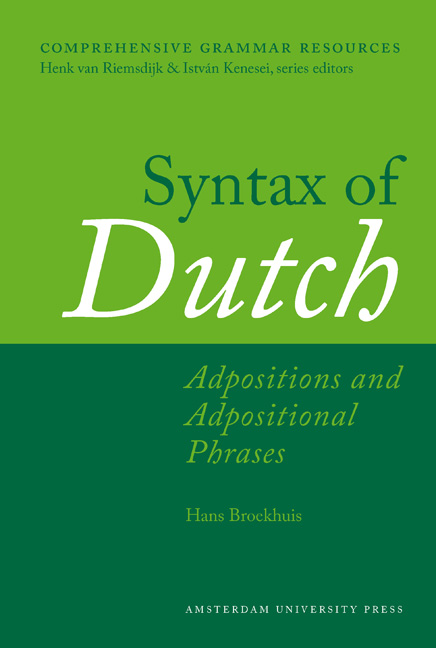Book contents
- Frontmatter
- Contents
- Abbreviations and symbols
- Preface and Acknowledgments
- Introduction
- Chapter 1 Adpositions: Characteristics and Classification
- Chapter 2 Projection of Adpositional Phrases: Complementation
- Chapter 3 Projection of Adpositional Phrases: Modification
- Chapter 4 Syntactic uses of the Adpositional Phrase
- Chapter 5 R-pronominalization and R-words
- Glossary
- Subject Index
- References
- Miscellaneous Endmatter
- Miscellaneous Endmatter
Chapter 5 - R-pronominalization and R-words
- Frontmatter
- Contents
- Abbreviations and symbols
- Preface and Acknowledgments
- Introduction
- Chapter 1 Adpositions: Characteristics and Classification
- Chapter 2 Projection of Adpositional Phrases: Complementation
- Chapter 3 Projection of Adpositional Phrases: Modification
- Chapter 4 Syntactic uses of the Adpositional Phrase
- Chapter 5 R-pronominalization and R-words
- Glossary
- Subject Index
- References
- Miscellaneous Endmatter
- Miscellaneous Endmatter
Summary
Introduction
This section is devoted to R-PRONOMINALIZATION and R-EXTRACTION. The first notion refers to pronominalization of the nominal complement of a preposition by means of a so-called R-word, which must precede the preposition. In (3) we give two examples with the R-word er, which will be glossed as there for reasons that will become clear when we discuss the examples in (6).
(1) a. Jan kijkt naar de film. a′. Jan kijkt ernaar.
Jan looks at the movie the movie there.at
‘Jan is watching the movie.’ ‘Jan is watching it.’
b. Jan wacht op de bus. b′. Jan wacht erop.
Jan waits for the bus Jan waits there.on
‘Jan is waiting for the bus.’ ‘Jan is waiting for it.’
Pronominal R-words like er will normally be referred to as R-PRONOUNS, although we will also use the notation [+R] pronouns when they are discussed in contrast to [-R] pronouns like hij/hem ‘he/him’. The combination of an R-pronoun and its associate adposition will be referred to as a PRONOMINAL PP.
Table 1, which is based on the classification of the pronouns developed in Section N5.2, shows that all third person, non-anaphoric [-R] pronouns that can be used independently as arguments have a [+R] counterpart. The fact that these [+R] pronouns all contain an /r/ is responsible for their name.
Table 1 shows that the [-R] pronouns can be divided into four main groups by means of the features [±NEUTER] and [±HUMAN]. For the referential, demonstrative and relative pronouns (group A), the gender distinction is the most prominent one, although it must be noted that most nouns that refer to [+HUMAN] entities are [-NEUTER] as well; nouns with the feature constellation [+NEUTER] and [+HUMAN] are typically diminutives (exceptions are the noun meisje ‘girl’, which has the formal characteristics of a diminutive, the noun kind ‘child’, and a number of nouns with a negative connotation like wijf ‘bitch of a woman’ and mens ‘person’). For the interrogative and quantificational pronouns (group B), only the distinction between [+HUMAN] and [-HUMAN] is relevant. As illustrated in (2), and to be discussed more extensively in Section 5.1, [+R] pronouns are typically, but not exclusively, used as alternative realizations of [-HUMAN] pronouns; see Table 2 in Section 5.1.7 for an overview.
Information
- Type
- Chapter
- Information
- Syntax of DutchAdpositions and Adpositional Phrases, pp. 291 - 362Publisher: Amsterdam University PressPrint publication year: 2013
